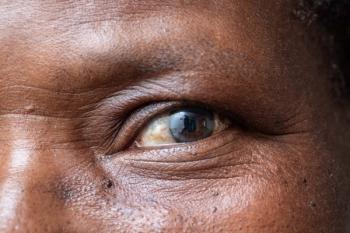
TTT stabilizes vision in advanced AMD-related CNV
Coronado, CA—Transpupillary thermotherapy (TTT) alone and combined with a single pretreatment intravitreal injection of triamcinolone acetonide 4 mg are similarly associated with vision stabilization over a 6-month follow-up period in eyes with large complicated choroidal neovascularization (CNV) secondary to age-related macular degeneration (AMD), reported Jans Fromow-Guerra, MD, PhD, at the annual meeting of the American Society of Retinal Specialists.
He presented the results from a randomized, prospective study comparing the two treatments in 26 eyes of 26 patients with CNV of any angiographic type (classic, minimally classic, or occult) that was ineligible for verteporfin (Visudyne, Novartis/QLT Inc.) photodynamic therapy. In both study groups, mean visual acuity was hand motion at baseline and remained at that level after 6 months.
However, while the two treatment groups were comparable with respect to several features at baseline, the TTT plus triamcinolone group had a larger mean lesion size compared with TTT-treated eyes (6.5 versus 3 MPS disc diameters) and included more eyes with presence of subretinal fluid (86% versus 56%).
"Considering that the combined treatment group had worse lesions at baseline, the results suggest there may be a benefit for using triamcinolone prior to TTT," said Dr. Fromow-Guerra, retina department, Asociacion Para Evitar la Ceguera en Mexico, Mexico City. "Further studies are needed to investigate that issue and to determine whether the vision stabilization observed in these eyes reflects the natural history of the disease or a benefit from treatment."
In the study, 14 eyes underwent TTT alone and 12 eyes received an intravitreal injection of triamcinolone 7 days prior to TTT. TTT was performed with an 810-nm diode laser at the slit lamp using a variable spot size (1.2 to 3 mm) to cover 500 µm plus the longest diameter of the membrane. Depending on lesion size, power ranged from 300 to 700 mW; treatment duration was 60 seconds for membranes ≤5,400 µm and 90 seconds for larger lesions.
At baseline, the two study groups were similar with respect to mean age (~74 years), gender (~57% female), and time since the onset of diminished central visual acuity (~11 months).
Retina edema was present in 10 (71%) eyes in the TTT group and in seven (58%) of the eyes receiving combination treatment.
Although mean visual acuity levels remained unchanged at hand motion in both groups, the two treatments were each associated with a slight mean improvement in vision.
In the TTT group, there was a mean visual acuity gain of 0.73 lines (range, –2 to 5); visual acuity was stable in 72% of eyes and improved by >2 lines in 21%. The mean gain in visual acuity for eyes receiving the 0.50 lines (range, –3 to 3); 67% of eyes had stable acuity, and 16.5% benefited with a gain of >2 lines.
Results from the fluorescein angiography and OCT studies were assessed by an investigator unaware of treatment assignment.
After 6 months, membrane closure was observed in three (21%) eyes having TTT alone and in four (33%) eyes in the TTT plus triamcinolone group.
Reduction of macular thickness The OCT studies showed the triamcinolone treatment was beneficial for reducing macular thickness and subretinal fluid. Mean macular thickness was about 450 µm at baseline in both groups.
At 1 month post-treatment, mean macular thickness had increased to 516 µm in the TTT group but was reduced significantly to 430 µm in the combined treatment group.
Macular thickness remained unchanged in the TTT group at 3 months but returned to its baseline level in the TTT plus triamcinolone group.
During follow-up, the proportion of eyes with subretinal fluid increased in the TTT group to reach 67% at 3 months, whereas in the TTT plus triamcinolone group, only 50% of eyes had evidence of subretinal fluid on OCT at 3 months post-treatment.
Newsletter
Don’t miss out—get Ophthalmology Times updates on the latest clinical advancements and expert interviews, straight to your inbox.



















































.png)


